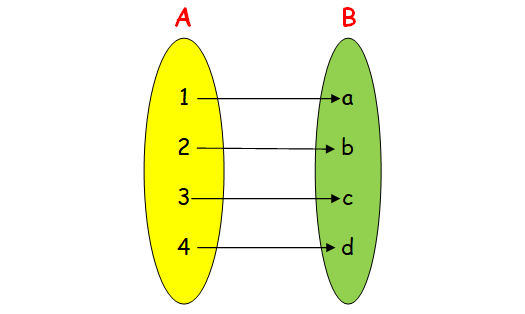HOW TO CHECK IF THE GIVEN RELATION IS FUNCTION
Let A and B be any two non empty sets. A relation 'f' from A to B is a function, if A ⊆ B such that the following hold:
(i) Domain of f is A.
(ii) For each x ∊ A, there is only one y ∊ B such that (x, y) ∊ f.
Problems 1-2 : State whether the following relations are functions or not. If it is a function, check for one-to-one onto. If it is not a function, state why?
Problem 1 :
A = {a, b, c} and f = {(a, c), (b, c), (c, b)}; (f : A ---> A).
Solution :
In order to check, if the given relation form a function, it has to satisfy the following conditions.
(i) Domain of f = {a, b, c} = set A.

(ii) For each x ∊ A, there is only one y ∊ A. Hence it is a function.
Not One to One :
If it is one to one function, then each elements of A will be associated with different elements of A. Here the elements a and b are associated with c.
Not Onto :
The element a is not associated with any of the elements, hence it is not onto.
Problem 2 :
If X = {x, y, z} and f = {(x, y), (x, z), (z, x)}; (f : X ---> X).
Solution :
(i) Domain of f = {x, z} ≠ set X
Hence it is not a function.
Problem 3 :
Let A = {1, 2, 3, 4} and B = {a, b, c, d}.
Give a function from A ---> B for each of the following :
(i) neither one-to-one nor onto.
(ii) not one-to-one but onto.
(iii) one-to-one but not onto.
(iv) one-to-one and onto.
Solution :
(i) neither one-to-one nor onto.
First let us draw a arrow diagram under the given condition, then write the relation from the arrow diagram.

It is not one to one, because 1 and 2 are having same image b.
It is not onto, because a is not having preimage.
Hence the required relation is {(1, b) (2, b) (3, c) (4, d)}
(ii) not one-to-one but onto.
Inorder to prove it is an onto function, every element of B should have atleast one preimage. If we associate each elements of B with A, we will get one to one function or not a function.
Hence it is not possible.
(iii) one-to-one but not onto
To prove it is an one to function, we need to associate every element of A with different elements of B. By doing this we will not get onto function. Hence it is not possible.
(iv) one-to-one and onto.

To prove it is an one to function, we need to associate every element of A with different elements of B. It is also an onto function.
Hence the required relation is {(1, a) (2, b) (3, c) (4, d)}.
Kindly mail your feedback to v4formath@gmail.com
We always appreciate your feedback.
©All rights reserved. onlinemath4all.com
Recent Articles
-
Digital SAT Math Problems and Solutions (Part - 146)
Apr 18, 25 06:52 AM
Digital SAT Math Problems and Solutions (Part - 146) -
Logarithmic Derivative Problems and Solutions
Apr 16, 25 09:25 PM
Logarithmic Derivative Problems and Solutions -
Digital SAT Math Problems and Solutions (Part - 145)
Apr 16, 25 12:35 PM
Digital SAT Math Problems and Solutions (Part - 145)

